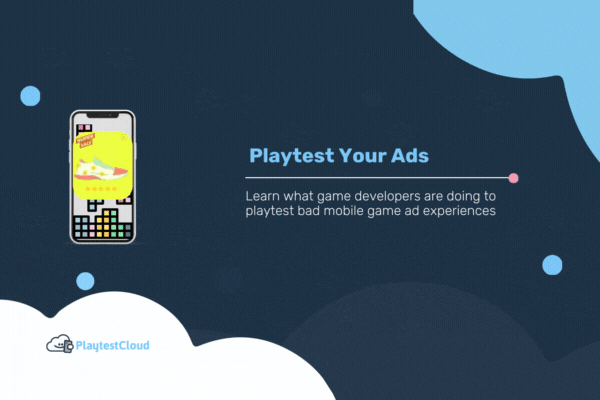When mobile games first hit the market, even console players were sold on this new ‘revolution’ in gaming. At a time when buying a game in-store or online was common, the idea that most of the games available for download could be offered for free disrupted the entire gaming industry.
We all know what happened next, however.
Free games couldn’t stay free, and very quickly mobile game studios began to monetize their games using advertising. Soon ads would appear as mini ‘commercials’ during every in-game experience. Did you fail a level and want to retry? Now you have to watch an ad. Finish a level and want to go back to the home screen? Probably have to watch an ad.
The problem is, these ads can have a big impact on a player’s gaming experience–and not always for the positive.
You completely ruin the immersion into a game when you go somewhere else and watch an ad. Even if it’s for something that gives you benefit in the game, you still lose that sense of in-game play.
That’s Jack Dunne, Head of Operations at PlaytestCloud. He says players generally perceive mobile games as too ad-heavy, especially those who don’t play mobile games as often as our playtesters.

So, what are game studios doing to combat that perception?
We recently sat down to ask Jack this very question. According to him, one of the most novel ways game-makers are tackling churn-inducing ad impacts is with ad playtesting.
As he says, there are so many great games that aren’t ad-heavy, who do a really good job of subtly putting ads in, or rewarding players well with ads. The ‘secret formula’ is, these game-makers often have great user research partnerships that make this type of ad placement optimization possible.
But just what is ad playtesting? And what are game studios learning from their results?
Now that we’ve managed our fair share of ad playtests through PlaytestCloud, we thought we would tap Jack for his two cents on this question and more when it comes to in-game ads, user research, and ad playtesting.
Already thinking on how to start playtesting your ads or find out if it's for you? Reach out and let us know how we can help!
The Problem with Mobile Game Ads
When I am playing…I am locked in. This is the game I am playing, this is the thing I am doing on my phone. I don’t need to watch an ad.
Jack’s sentiment here sums up just what players are thinking when they’re forced to watch an ad during their in-game experience: I would rather not.
And yet, it would seem that some game developers forget about their days as players when it comes to creating space for ads within their games. As writer Tamaka Kee explains:
Making sure players get to actually enjoy the game before seeing an ad seems like common sense, but in the rush to generate revenue, overzealous mobile game developers can forget about enticing with gameplay first.

That’s the biggest problem right now with mobile game ads: game studios aren’t focusing enough on ad placement throughout gameplay–only on how many ads they can pack into their game before losing too many players. “We have even seen a playtest or two come in where it was unethical the amount of ads in it!” says Jack.
The evidence doesn’t stop there. The industry is for example seeing an increase in reviews that state “This game has so much potential, if it weren’t for the ads.” Along the same lines, bad ad placement or disruptive ad types like interstitial ads are often seen as both disruptive and annoying.
Imagine, for example, you’ve just passed a difficult level and you’re happy about it. Watching an interstitial ad[1] - the kind that takes over your whole screen without you ‘opting in’ - might not seem so bad in that moment. You’re feeling good and you need a small break from gameplay anyway.
Interstitial ads are full-screen ads that cover the interface of their host app. They're typically displayed at natural transition points in the flow of an app, such as between activities or during the pause between levels in a game. ↩︎
Now think about how you would feel if you’d just been defeated by another player. Because you may be upset or eager to get back to the game, you aren't in the mood to see an ad. Not only do you have negative connotations towards what’s being advertised, but research into in-game advertising shows that players see ads played after in-game defeats as deal-breakers, leading them to quit the game entirely.
Not that these are the only problems commonly associated with bad mobile game ad experiences.

On LinkedIn I follow the Puzzle Society, and they are known to call out terrible ad experiences that are particularly misogynistic, or frankly inappropriate, or have nothing to do with the game itself,” says Jack. “There is a big trend of ethics in computer design at the moment and some ads do not match up to any of them.
According to Claire Rozain - creator of the Puzzle Society - the volume of these bad ad interactions continues to sky-rocket: almost 80% of gamers in the US “have witnessed gender misrepresentations and stereotypes in the gameplay of the mobile games they play.”

These misguided ethics, it seems, extend right over into ad design, where ads are built to make sure you click through and get into the app store as their main function. “A lot of them are deceptive in how they set themselves up,” says Jack. Yet, he also sees that game studios aren’t necessarily responsible for the bad ad experiences we sometimes get in-game:
A lot of the ad experiences are through no fault of the people who are making the games…[ad development] is outsourced completely to ad tech companies, and their goal is to get people to click the ad–not to get people familiar with the game at all.
He continues:
I remember a lot around GardenScapes a couple of years ago, where the ads showed players saving the bachelor, Alfred, and that had nothing to do with the gameplay at all…so I think it’s important to state that a lot of the bad experiences people see with ads aren’t coming from the game developers themselves. They are not the ones who should be getting flack for it.

Popular game developers on the market would agree. Take Kolibri Games, creators of the ‘Idle Tycoon’ mobile series. Together the team acknowledges that the trend for ads today is toward higher-quality, interactive, and playable ads (themselves in need of a host of testing). Although these playable ads are the ‘latest trend’, they cost more money, and more time to create. “Sometimes, the playables are so well-made, they look better than the game itself, which can be disappointing for the players.
Faced with multiple challenges on all ad fronts - from placement, to timing, to type, to design - we asked Jack next: What can mobile game studios do in-house to offset bad in-game ad experiences?
What Can Game Developers Do to Fix Bad Mobile Game Ad Experiences?
It may seem like a no brainer, but Jack says game developers need to make sure their game is all sorted out before they start thinking too much about ad playtesting. By the time these developers are throwing players at their finished game, they’ll be in a better position to think about ad placement anyway. Translation? Don’t get carried away with that element of design and development too early. You could lose out on precious resources in the long run!
Of course, the ability for a game studio to support good ad playtesting also depends on the size of that organization. As Jack notes:
For game studios that have the people power and the budget to do user research on ads, it’s worthwhile to figure out what people like, and what they don’t like in the experience, and then try to understand the point of frustration.
The best way to do that? Ad playtesting!
What is Ad Playtesting for Mobile Games?
“Mobile game developers need to decide which specific moments between levels, tasks or other gameplay elements will be best for integration,” says Tamaka Kee in a recent article.
That’s the central goal of playtesting ads for mobile games, a process that focuses on when to run ads in your mobile game, how often, and the types of ad units to include.
“So, if you get a reward for an ad, [playtesting means] figuring out what the value of that chest should be. For hyper-casual games that include ads right after a round, they just need to figure out the frequency they want to do that at,” says Jack.
These playtesting elements are based on the two main types of ads in gameplay, with each requiring different research goals during ad playtesting. Between rewarded video ads, where players get virtual currency or benefit in exchange for watching a video, viewing a banner ad, or sitting through those interstitial ads we mentioned before, games user researchers have plenty of testing options to work with.
For example, bigger marketing departments for mobile games will test different ad styles and types separately from their games using concept tests or surveys, and then will compare the results against each other. Jack says these departments will for example run a bench-mark study, where they will test, say, five ads, and compare each one against the other–though this is something we at PlaytestCloud weren’t able to do up until a few months ago.
“Now we’re able to see those ads, see how players are experiencing those, and what happens from there,” says Jack. This has led PlaytestCloud to build some really fun and informative custom ad playtests this last year!

How We Playtest Ads with Mobile Game Studios
Jack says that on the LiveOps side of things, the process of playtesting ads in general has a ton of room to grow, since you can do so much with a/b testing ads out in the wild:
Watching people watch ads in mobile games is still pretty novel. Once a game is at that stage where the studio is hypothesizing where they should put their ads, it becomes a bit more of a math formula, with much bigger datasets than watching five or ten people interact with an ad. We’re talking datasets of 300 or 400 players!
That isn’t to say that playtesting ads for mobile games is so new that we don’t know anything about what players like and don’t like about ads during gameplay.
Some experts have for instance reported that interstitial ads should have at least two players actions between them, and should not automatically be shown at every stage of gameplay. These same experts argue that frequency testing is a great jumping off point for ad playtesting, so you can watch how players behave.
Luckily, PlaytestCloud already has a ton of existing infrastructure to record player behavior for observation, including running a/b tests with ad variations, testing user retention, posting playtest surveys and interviews, and so on. At the moment, folks can do it by ordering a Concept Test, a playtest, or by running a Competitor Test and comparing the results through the regular user research processes that go along with playtesting.
Given these product offerings, we have now seen several playtests come in from big-name game studios geared toward testing ad content and placement, where the main goal is to find a happy balance between profitability and churn. According to Jack, they also utilize different player experiences than your average mobile game playtest. As he explains, “Where playtesters are used to sessions that last 15 minutes, the ad experiences being tested are somewhere between 15 and 30 seconds long.”
PlaytestCloud has a flexible network of playtest customizations that can respond to almost any research goal for ads placement and development. For example, we’ve hosted an ad playtest where ten ads were being compared against each other, with about 40 people in each test. In that case we would compare ads based on whether people enjoy the ad itself, or if it’s more so because of the brand it's associated with, or even because of the reward it's associated with in game. We’ve created ad playtests for what different characters look like during ad presentations, surveying players about their reception to a certain creature or character post-session. We’ve even built playtests which determine how players spend money in the game through ads. “Part of that is asking what experience do people enjoy the most? What will cause the least amount of friction when they need to watch an ad for 45 seconds?” asks Jack.
Whatever the playtest, or playtesting research goal, when game studios or game developers create or request ad playtests, it’s best when they are able to test with the people who are going to be playing their game. That can be the audience they have already, or the audience of their competitors. With a player base of over 1M players, PlaytestCloud is well-equipped to provide the numbers for those big dataset ad playtests, and we’re pretty certain that’s a big part of why many clients chose us.
Not that we want to forget about smaller game studios or indie developers, who might not have the budget for large-scale ad playtesting.
So we asked, how would Jack set up a quick ad playtest for a small-time game studio? His answer has a lot to do with what not to do as a beginner in the field of ad playtesting.
The biggest mistake I see folks making is trying to get one person to compare five or ten ads against each other. The human brain just cannot do that!
When figuring out how to set up a playtest where you want to know how people are feeling about the ad experience, Jack therefore suggests creating a playtest with tasks that appear after the ad itself. That way you can understand what playtesters remember about the ad after moving away from it, as well as what their general sentiment about the ad or game was as a whole. Like he says, “You can figure out a lot from a general small appreciation test with us.”
As PlaytestCloud continues to articulate what it means to playtest ads for mobile games, we couldn’t leave our discussion without asking Jack one final question: what’s next for ads in the world of mobile games development?

The Future of Ads and Ad Playtesting for Mobile Games
Seeing bigger game studios use their resources to reduce the negative impacts that ads can have on gameplay, churn, and profits is a great indicator that ad playtesting is going to be ‘the next big thing’ in mobile game playtesting. And while ethical mobile game developers continue to do all they can to provide great ad experiences, we’re happy to report that some studios are already thinking a lot differently about mobile game ads.
Survivor.io is one example where they find the perfect sweet spot of me being willing to sit there for 30 seconds watching an ad, when otherwise I probably wouldn’t.
According to Jack, this aspect of Survivor.io’s game design could have huge implications for the future of ads during gameplay. All of the ads in the game are rewarded, for example, and they never appear at the end of a round–meaning you’re always getting perceived value in return for your time. This ‘opt-in’ aspect is huge when it comes to the ethics of consensual ad viewing as well.
Another game to keep our eyes on for ad placement inspiration is MARVEL SNAP, which has no ads at all. Instead players purchase a battle pass system with credits that allow you to make your game cards visually look better, but this is all optional as well. “Technically, you can play the game for free,” says Jack, “and what they’re doing is getting a really core group of players that play a certain type of game…who are willing to pay $12 for a battle pass, for example.”
At PlaytestCloud, we continue to be inspired by what these game studios are doing to avoid bad mobile game ad experiences. Jack himself sees these newer monetization models as game-changing to the world of in-game mobile ads! That’s why we at PlaytestCloud are so looking forward to building up our capacity as a hub for responsible, fully customizable ad playtesting for mobile game developers across the globe.
That means, if you’ve got a mobile game in development, or already live on the app store, and think you’re ready to build a custom ad playtest, we want to hear from you! Our inboxes are open for you to reach out to us.
We can’t wait to see what you come up with…and be sure to let us know how else we can help you build incredible game-play experiences through dedicated games user research.


